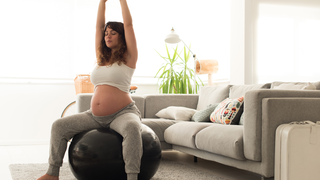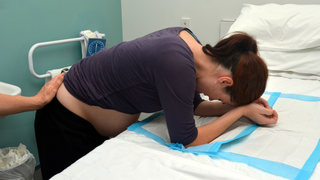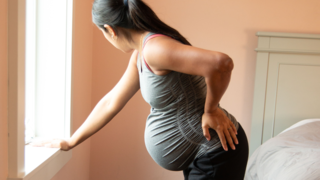In this article:
Why Should You Practise Labour Positions Before Birth?
The labour positions are not merely poses; they assist your baby to shift to the most perfect posture for birthing, as well as to relieve the strain on your back and hips. Their practice can make your body feel better prepared and help your partner to know how to assist you once the birth process commences.Research indicates that upright postures during labour may shorten labour periods by 25-30 per cent and may enhance oxygen delivery to the baby. By combining these positions with your partner, you each learn to move, breathe, and cope more effectively during contractions.
How Does Partner Involvement Make a Difference?
It is not merely a physical experience that happens during labour, but a psychological one as well. Your partner has to be emotionally strong and a practical support to you.Here’s how your partner’s participation helps:
- Offers relief and reassurance when contractions become more intense
- Communicate better to help your partner understand how to assist you, such as by putting pressure on your lower back or helping you change positions
- Minimises anxiety through the feeling of teamwork and trust
- Fosters intimacy as you both wait to see your baby together
What Labour Positions Can You Practise Together?
Here are a few simple and effective positions you can start practising safely:1. Supported squat: You position your feet with your shoulders apart, and your partner holds you straight at your back under your arms. This will open your pelvis, thereby assisting the baby to come down, and relieve the lower back pressure.
2. Hands and knees position: You lie on your hands and knees with your partner rubbing your back. This pose helps alleviate back pain and allows the baby to roll into a good position for delivery.
3. Side-lying position: You lie on your side with a pillow between your knees while your partner provides back support. This position is great for resting during long labours and helps maintain good blood flow.
4. Rocking or swaying together: Facing your partner, hold onto his shoulders. Move side to side slowly or in little circles. This assists in relaxation and maintaining the baby on the pelvis.
5. Birth ball support: Lean forward while sitting on a birthing ball, with your partner massaging your shoulders or holding your arms up. This will take the weight off the pelvis and improve balance.
What are the Benefits of Practising Together?
Practising labour positions with your partner brings multiple benefits, for both your body and your relationship:- Easier labour progression due to gravity-friendly movements
- Breathing and relaxation can help manage the pain
- There is less fear and anxiety due to familiarity
- Better belief in dealing with contractions
- Better emotional bond with your partner
What If You Feel Nervous About Practising?
It is quite natural to be uncertain in the beginning. You might be afraid of doing the positions wrong or appearing clumsy. Remember, it is not about perfection; it is about preparation.Begin with short practices of 10-15 minutes, two or three times a week. Pillows or a birthing ball can help you get comfortable, and you should work on breathing together. After a while, you will become more confident and coordinated.
When Should You Talk to Your Doctor or Birth Coach?
Before starting, check with your doctor, especially if you have:- High blood pressure or complications like preeclampsia
- Placenta previa or low-lying placenta
- Back or pelvic pain that worsens with movement
- Dizziness or shortness of breath during activity
What To Do Next: Your Practice Checklist
Here’s a simple way to get started:- Discuss with your physician safe practice alternatives
- Choose 2-3 labour positions to start with
- Arrange a weekly practice time with your partner
- Always pay attention to breathing and communication
- Movement calms the atmosphere - play music, dim the lights, and take a break
- Assess your progress after every few weeks and introduce new positions
Emotional and Social Impact
Childbirth is not just a medical procedure but an emotional process. Being together with your partner also enables you to bond, laugh, and even get past fears. When the contractions arrive, your partner becomes your anchor, building trust and collaboration.This practice creates a feeling of safety and confidence on an emotional level. Being aware that you are also ready can lower the stress hormones and make labour easier and less tense.
The practice of labour in the presence of your partner is not only a matter of physical preparation, but also of emotional preparation, teamwork, and confidence. Each exercise session you attend brings you one step closer to understanding your body and developing a better connection with your partner. By the time the big day comes, you both will be more in tune, more relaxed, and better prepared to bring your baby into the world.
Whether you’re pregnant, a new mom, or navigating postpartum, you don’t have to do it alone. Join our support group to connect, share, and support one another.
FAQs on How Practising Labour Positions With Your Partner Helps
- When should I start practising labour positions during pregnancy?
You can typically begin in the second or first trimester, as verified by the doctor to be safe. Start with little and pay attention to the levels of comfort in your body. - Can practising labour positions really make childbirth easier?
Yes, research shows that practising upright and supported positions can shorten labour, improve comfort, and promote better baby positioning. - What if my partner can’t attend all practice sessions?
That’s okay. Even practising once a week together helps build coordination. You can also practise breathing and light stretches on your own.










